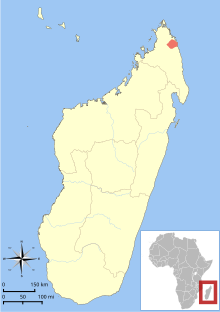Gold crown sifaka
| Gold crown sifaka | ||||||||||||
|---|---|---|---|---|---|---|---|---|---|---|---|---|

Golden Crowned Sifaka ( Propithecus tattersalli ) |
||||||||||||
| Systematics | ||||||||||||
|
||||||||||||
| Scientific name | ||||||||||||
| Propithecus tattersalli | ||||||||||||
| Simons , 1988 |
The Golden Crowned Sifaka or Tattersall Sifaka ( Propithecus tattersalli ) is a species of primate from the family of Indri-like within the lemurs .
features
Golden crowned sifakas are the smallest representatives of the sifakas . They reach a head body length of 45 to 47 centimeters, the tail measures 42 to 47 centimeters and the weight is 3.4 to 3.6 kilograms. Its fur is predominantly white in color, the name-giving feature is the orange-yellow top of the head. A similar shade is also sometimes found on the shoulders, upper arms, and chest. The hairless face is colored black, the eyes are orange. The white tufts on the ears are striking.
distribution and habitat
Golden crowned sifakas, like all lemurs, only occur in Madagascar . They inhabit a small area in the far north of the island, which lies between the Loky and Manambato rivers. Their habitat are dry deciduous and gallery forests, mostly they can be found below 500 meters above sea level.
Way of life
These primates are mostly diurnal, but in the rainy season they can sometimes be seen before dawn or after dusk. At night they sleep in higher trees. They usually stay in the trees and move vertically climbing and jumping. They live in groups of three to ten (usually five or six) animals, which are composed of several males, several females and the common young animals. The group members communicate with several sounds, so they have their own alarm screams for birds of prey and for ground-dwelling predators. The size of the districts varies between 6 and 12 hectares, the length of the daily forays between 400 and 1200 meters - in the dry season they have to cover greater distances due to the scarce food supply.
They are herbivores that feed on young leaves, unripe fruits, seeds, buds, and flowers.
After a gestation period of around 170 days, the female gives birth to a single young in July. This initially clings to her stomach and later rides on her back. It is weaned at around five months. A female can give birth to offspring every two years.
Danger
The distribution area of the golden crowned sifakas covers less than 5000 km² and is very fragmented. Deforestation, slash and burn and mining reduce their habitat, and hunting is an additional factor. The total population is estimated at 6,000 to 10,000 animals that IUCN lists the species as "critically endangered" ( endangered ).
Discovery and systematics
The species was first observed in 1974 by Ian Tattersall , who initially thought it was a population of the silky sifaka . In 1988 it was described as a separate species and named after Tattersall. To this day it is controversial as to which of the two species groups the sifakas the golden crowned sifaka belongs to . Mittermeier et al. (2008) provisionally assign it to the verreauxi group, i.e. as a closer relative of the larval sifaka .
literature
- Nick Garbutt: Mammals of Madagascar. A Complete Guide. Yale University Press, New Haven CT 2007, ISBN 978-0-300-12550-4 .
- Thomas Geissmann : Comparative Primatology. Springer-Verlag, Berlin et al. 2002, ISBN 3-540-43645-6 .
- Russell A. Mittermeier , Jörg U. Ganzhorn, William R. Konstant, Kenneth Glander, Ian Tattersall , Colin P. Groves , Anthony B. Rylands, Andreas Hapke, Jonah Ratsimbazafy, Mireya I. Mayor, Edward Louis jr, Yves Rumpler, Christoph Schwitzer, Rodin Rasoloarison: Lemur Diversity in Madagascar. In: International Journal of Primatology. 29, 2008, ISSN 0164-0291 , pp. 1607-1656.
Web links
- Information, photos and videos on arkive.org
- Propithecus tattersalli onthe IUCN Red List of Threatened Species . Retrieved April 26, 2009.
